98-thymeleaf
- 早期开发,完成的都是静态html页面。随着时间发展,引入了jsp,当在后端服务查询到数据之后可以转发到jsp页面,可以轻松的使用jsp页面来实现数据的显示及交互,jsp有非常强大的功能
- 但是,使用SpringBoot,整个项目是以jar包而不是war包的方式运行,而且还嵌入了Tomcat容器。因此默认情况下是不支持jsp。如果直接以纯静态页面方式会给开发带来很大麻烦,SpringBoot推荐使用模板引擎
- 模板引擎有很多种(jsp、freemarker、thymeleaf)。模板引擎的作用:将动态数据填充到页面模板指定位置,生成页面
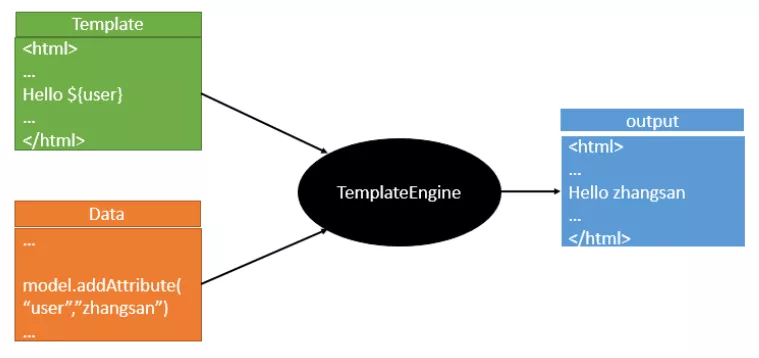
1. 介绍
<!-- thymeleaf模板 -->
<dependency>
<groupId>org.thymeleaf</groupId>
<artifactId>thymeleaf-spring5</artifactId>
</dependency>
<dependency>
<groupId>org.thymeleaf.extras</groupId>
<artifactId>thymeleaf-extras-java8time</artifactId>
</dependency>
- SpringBoot中有专门的thymeleaf配置类:
ThymeleafProperties
@ConfigurationProperties(prefix = "spring.thymeleaf")
public class ThymeleafProperties {
private static final Charset DEFAULT_ENCODING = StandardCharsets.UTF_8;
public static final String DEFAULT_PREFIX = "classpath:/templates/";
public static final String DEFAULT_SUFFIX = ".html";
/**
* Whether to check that the template exists before rendering it.
*/
private boolean checkTemplate = true;
/**
* Whether to check that the templates location exists.
*/
private boolean checkTemplateLocation = true;
/**
* Prefix that gets prepended to view names when building a URL.
*/
private String prefix = DEFAULT_PREFIX;
/**
* Suffix that gets appended to view names when building a URL.
*/
private String suffix = DEFAULT_SUFFIX;
/**
* Template mode to be applied to templates. See also Thymeleaf's TemplateMode enum.
*/
private String mode = "HTML";
/**
* Template files encoding.
*/
private Charset encoding = DEFAULT_ENCODING;
/**
* Whether to enable template caching.
*/
private boolean cache = true;
/**
* Order of the template resolver in the chain. By default, the template resolver is
* first in the chain. Order start at 1 and should only be set if you have defined
* additional "TemplateResolver" beans.
*/
private Integer templateResolverOrder;
/**
* Comma-separated list of view names (patterns allowed) that can be resolved.
*/
private String[] viewNames;
/**
* Comma-separated list of view names (patterns allowed) that should be excluded from
* resolution.
*/
private String[] excludedViewNames;
/**
* Enable the SpringEL compiler in SpringEL expressions.
*/
private boolean enableSpringElCompiler;
/**
* Whether hidden form inputs acting as markers for checkboxes should be rendered
* before the checkbox element itself.
*/
private boolean renderHiddenMarkersBeforeCheckboxes = false;
/**
* Whether to enable Thymeleaf view resolution for Web frameworks.
*/
private boolean enabled = true;
private final Servlet servlet = new Servlet();
private final Reactive reactive = new Reactive();
}
2. 使用模板
@RequestMapping("/thymeleaf1")
public String thymeleaf1(Model model) {
model.addAttribute("msg", "hello, thymeleaf");
return "01_html";
}
<!DOCTYPE html>
<html lang="en" xmlns:th="http://www.thymeleaf.org">
<head>
<meta charset="UTF-8">
<title>Title</title>
</head>
<body>
显示消息为:<p th:text="${msg}"></p>
</body>
</html>
3. 表达式语法
Simple expressions:
Variable Expressions: ${...}
Selection Variable Expressions: *{...}
Message Expressions: #{...}
Link URL Expressions: @{...}
Fragment Expressions: ~{...}
Literals
Text literals: 'one text', 'Another one!',…
Number literals: 0, 34, 3.0, 12.3,…
Boolean literals: true, false
Null literal: null
Literal tokens: one, sometext, main,…
Text operations:
String concatenation: +
Literal substitutions: |The name is ${name}|
Arithmetic operations:
Binary operators: +, -, *, /, %
Minus sign (unary operator): -
Boolean operations:
Binary operators: and, or
Boolean negation (unary operator): !, not
Comparisons and equality:
Comparators: >, <, >=, <= (gt, lt, ge, le)
Equality operators: ==, != (eq, ne)
Conditional operators:
If-then: (if) ? (then)
If-then-else: (if) ? (then) : (else)
Default: (value) ?: (defaultvalue)
Special tokens:
No-Operation: _
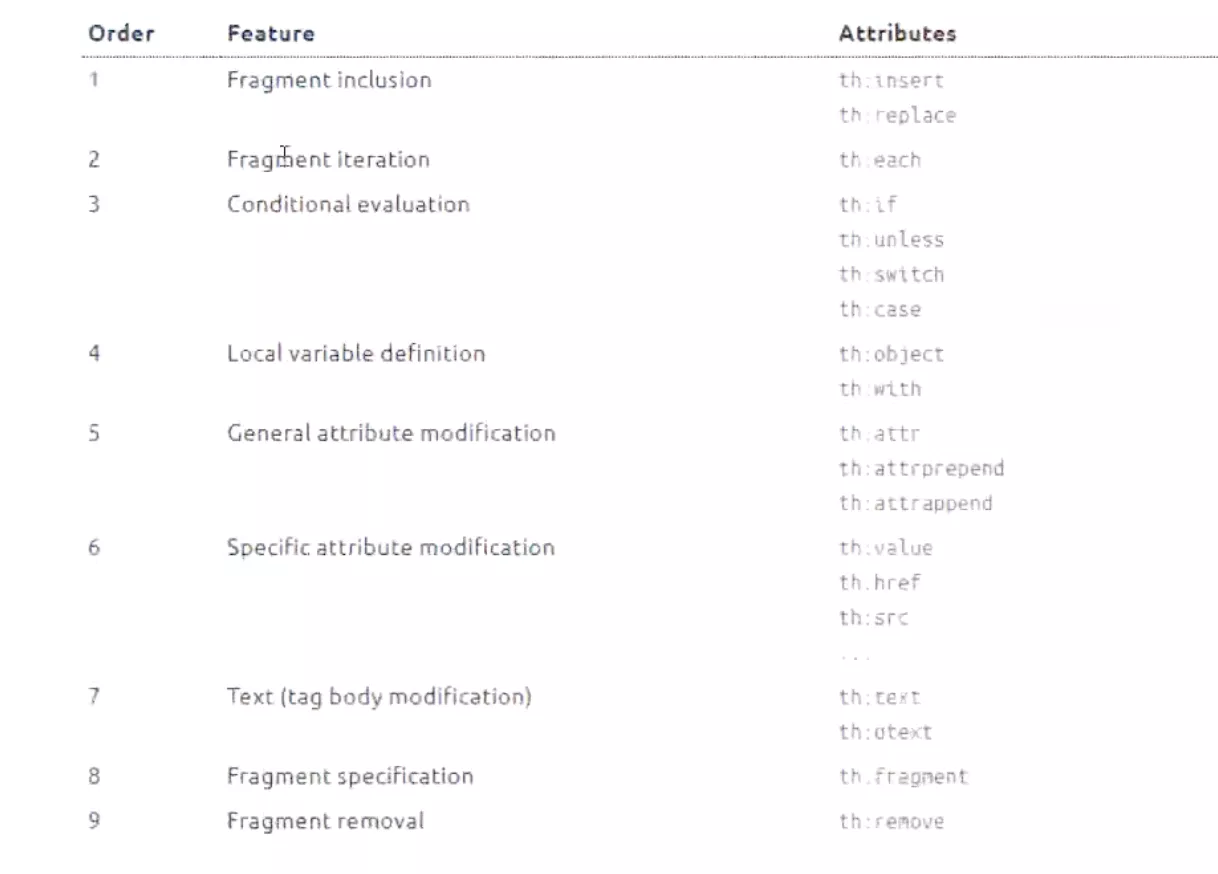
4. 实例演示
1. th常用属性值
th:text:设置当前元素的文本内容,相同功能的还有th:utext。前者不会转义html标签,后者会。优先级不高:order=7th:value:设置当前元素的value值,类似修改指定属性的还有th:src,th:href。优先级不高:order=6th:each:遍历循环元素,和th:text或th:value一起使用。注意该属性修饰的标签位置,详细往后看。优先级很高:order=2th:if:条件判断,类似的还有th:unless,th:switch,th:case。优先级较高:order=3th:insert:代码块引入,还有th:replace,th:include,三者区别较大,若使用不恰当会破坏html结构,常用于公共代码块提取。优先级最高:order=1th:fragment:定义代码块,方便被th:insert引用。优先级最低:order=8th:object:声明变量,一般和*{}一起配合使用,达到偷懒的效果。优先级一般:order=4th:attr:修改任意属性,实际开发中用的较少,类似还有th:attrappend,th:attrprepend。优先级一般:order=5
<!DOCTYPE html>
<html lang="en" xmlns:th="http://www.thymeleaf.org">
<head>
<meta charset="UTF-8">
<title>Title</title>
</head>
<body>
<p th:text="${thText}"></p>
<p th:utext="${thUText}"></p>
<input type="text" th:value="${thValue}">
<div th:each="message:${thEach}">
<p th:text="${message}"></p>
</div>
<div>
<p th:text="${message}" th:each="message:${thEach}"></p>
</div>
<p th:text="${thIf}" th:if="${not #strings.isEmpty(thIf)}"></p>
<div th:object="${thObject}">
<p>name:<span th:text="*{lastName}"/></p>
<p>age:<span th:text="*{age}"/></p>
<p>gender:<span th:text="*{sex}"/></p>
</div>
<p th:text="${session.name}"></p>
</body>
</html>
@RequestMapping("/thymeleaf2")
public String thymeleaf(ModelMap map, HttpSession session) {
session.setAttribute("name", "zhangsan");
map.put("thText", "th:text设置文本内容 <b>加粗</b>");
map.put("thUText", "th:utext 设置文本内容 <b>加粗</b>");
map.put("thValue", "thValue 设置当前元素的value值");
map.put("thEach", "Arrays.asList(\"th:each\", \"遍历列表\")");
map.put("thIf", "msg is not null");
map.put("thObject", new Person("zhangsan", 12, "男"));
return "thymeleaf";
}
2. 标准表达式
${...}变量表达式(Variable Expressions)*{...}选择变量表达式(Selection Variable Expressions)
- 可以获取对象的属性和方法
- 可以使用
ctx, vars, locale, request, response, session, servletContext内置对象 - 可以使用
dates, numbers, strings, objects, arrays, lists, sets, maps等内置方法
session.setAttribute("user","zhangsan");
th:text="${session.user}"
- strings:字符串格式化方法(
equals(), equalsIgnoreCase(), length(), trim(), toUpperCase(), toLowerCase(), indexOf(), substring(), replace(), startsWith(), endsWith(), contains(), containsIgnoreCase()) - numbers:数值格式化方法(
formatDecimal()) - boolean:布尔方法(
isTrue(), isFalse()) - arrays:数组方法(
toArray(), length(), isEmpty(), contains(), containsAll()) - lists、sets:集合方法(
toList(), size(), isEmpty(), contains(), containsAll(), sort()) - maps:对象方法(
size(), isEmpty(), containsKey(), containsValue()) - dates:日期方法(
format(), year(), month(), hour(), createNow())
<!DOCTYPE html>
<html lang="en" xmlns:th="http://www.thymeleaf.org">
<head>
<meta charset="UTF-8">
<title>thymeleaf内置方法</title>
</head>
<body>
<h3>#strings </h3>
<div th:if="${not #strings.isEmpty(Str)}">
<p>Old Str : <span th:text="${Str}"/></p>
<p>toUpperCase : <span th:text="${#strings.toUpperCase(Str)}"/></p>
<p>toLowerCase : <span th:text="${#strings.toLowerCase(Str)}"/></p>
<p>equals : <span th:text="${#strings.equals(Str, 'blog')}"/></p>
<p>equalsIgnoreCase : <span th:text="${#strings.equalsIgnoreCase(Str, 'blog')}"/></p>
<p>indexOf : <span th:text="${#strings.indexOf(Str, 'r')}"/></p>
<p>substring : <span th:text="${#strings.substring(Str, 2, 4)}"/></p>
<p>replace : <span th:text="${#strings.replace(Str, 'it', 'IT')}"/></p>
<p>startsWith : <span th:text="${#strings.startsWith(Str, 'it')}"/></p>
<p>contains : <span th:text="${#strings.contains(Str, 'IT')}"/></p>
</div>
<h3>#numbers </h3>
<div>
<p>formatDecimal 整数部分随意,小数点后保留两位,四舍五入: <span th:text="${#numbers.formatDecimal(Num, 0, 2)}"/></p>
<p>formatDecimal 整数部分保留五位数,小数点后保留两位,四舍五入: <span
th:text="${#numbers.formatDecimal(Num, 5, 2)}"/></p>
</div>
<h3>#bools </h3>
<div th:if="${#bools.isTrue(Bool)}">
<p th:text="${Bool}"></p>
</div>
<h3>#arrays </h3>
<div th:if="${not #arrays.isEmpty(Array)}">
<p>length : <span th:text="${#arrays.length(Array)}"/></p>
<p>contains : <span th:text="${#arrays.contains(Array,2)}"/></p>
<p>containsAll : <span th:text="${#arrays.containsAll(Array, Array)}"/></p>
</div>
<h3>#lists </h3>
<div th:if="${not #lists.isEmpty(List)}">
<p>size : <span th:text="${#lists.size(List)}"/></p>
<p>contains : <span th:text="${#lists.contains(List, 0)}"/></p>
<p>sort : <span th:text="${#lists.sort(List)}"/></p>
</div>
<h3>#maps </h3>
<div th:if="${not #maps.isEmpty(hashMap)}">
<p>size : <span th:text="${#maps.size(hashMap)}"/></p>
<p>containsKey : <span th:text="${#maps.containsKey(hashMap, 'thName')}"/></p>
<p>containsValue : <span th:text="${#maps.containsValue(hashMap, '#maps')}"/></p>
</div>
<h3>#dates </h3>
<div>
<p>format : <span th:text="${#dates.format(Date)}"/></p>
<p>custom format : <span th:text="${#dates.format(Date, 'yyyy-MM-dd HH:mm:ss')}"/></p>
<p>day : <span th:text="${#dates.day(Date)}"/></p>
<p>month : <span th:text="${#dates.month(Date)}"/></p>
<p>monthName : <span th:text="${#dates.monthName(Date)}"/></p>
<p>year : <span th:text="${#dates.year(Date)}"/></p>
<p>dayOfWeekName : <span th:text="${#dates.dayOfWeekName(Date)}"/></p>
<p>hour : <span th:text="${#dates.hour(Date)}"/></p>
<p>minute : <span th:text="${#dates.minute(Date)}"/></p>
<p>second : <span th:text="${#dates.second(Date)}"/></p>
<p>createNow : <span th:text="${#dates.createNow()}"/></p>
</div>
</body>
</html>
@RequestMapping("standardExpression")
public String standardExpression(ModelMap map) {
map.put("Str", "Blog");
map.put("Bool", true);
map.put("Array", new Integer[]{1, 2, 3, 4});
map.put("List", Arrays.asList(1, 3, 2, 4, 0));
Map<String, Object> hashMap = new HashMap();
hashMap.put("thName", "${#...}");
hashMap.put("desc", "变量表达式内置方法");
map.put("Map", hashMap);
map.put("Date", new Date());
map.put("Num", 888.888D);
return "standardExpression";
}
3. 链接表达式
@{...}:链接表达式(Link URL Expressions)
<!--
- 不管是静态资源的引用,form表单的请求,凡是链接都可以用@{...}。可以动态获取项目路径,即便项目名变了,依然可以正常访问
- 链接表达式结构
无参:@{/xxx}
有参:@{/xxx(k1=v1,k2=v2)} 对应url结构:xxx?k1=v1&k2=v2
- 引入本地资源:@{/项目本地的资源路径}
- 引入外部资源:@{/webjars/资源在jar包中的路径}
-->
<link th:href="@{/webjars/bootstrap/4.0.0/css/bootstrap.css}" rel="stylesheet">
<link th:href="@{/main/css/123.css}" rel="stylesheet">
<form class="form-login" th:action="@{/user/login}" th:method="post" >
<a class="btn btn-sm" th:href="@{/login.html(l='zh_CN')}">中文</a>
<a class="btn btn-sm" th:href="@{/login.html(l='en_US')}">English</a>
4. 消息表达式
#{...}:消息表达式(Message Expressions)
<!--
消息表达式一般用于国际化的场景。结构:th:text="#{msg}"
-->
5. 代码块表达式
{...}:代码块表达式(Fragment Expressions)
@RequestMapping("/fragment")
public String fragment() {
return "fragment";
}
<!--
支持两种语法结构
推荐:~{templatename::fragmentname}
支持:~{templatename::#id}
- templatename:模版名,Thymeleaf会根据模版名解析完整路:/resources/templates/templatename.html,要注意文件的路径
- fragmentname:片段名,Thymeleaf通过th:fragment声明定义代码块,即:th:fragment="fragmentname"
- id:HTML的id选择器,使用时要在前面加上#号,不支持class选择器
代码块表达式需要配合th属性`th:insert, th:replace, th:include`一起使用
- th:insert:将代码块片段整个插入到使用了th:insert的HTML标签中
- th:replace:将代码块片段整个替换使用了th:replace的HTML标签中
- th:include:将代码块片段包含的内容插入到使用了th:include的HTML标签中
-->
<!DOCTYPE html>
<html lang="en" xmlns:th="http://www.thymeleaf.org">
<head>
<meta charset="UTF-8">
<title>Title</title>
</head>
<body>
<!-- th:fragment:定义代码块标识 -->
<footer th:fragment="copy">
2019 The Good Thymes Virtual Grocery
</footer>
<!-- 三种不同的引入方式 -->
<div th:insert="fragment::copy"></div>
<div th:replace="fragment::copy"></div>
<div th:include="fragment::copy"></div>
<!-- th:insert:在div中插入代码块,即多了一层div -->
<div>
<footer>
© 2011 The Good Thymes Virtual Grocery
</footer>
</div>
<!-- th:replace:将代码块代替当前div,其html结构和之前一致 -->
<footer>
© 2011 The Good Thymes Virtual Grocery
</footer>
<!-- th:include:将代码块footer的内容插入到div中,即少了一层footer -->
<div>
© 2011 The Good Thymes Virtual Grocery
</div>
</body>
</html>
5. 国际化配置
在很多应用场景下,需要实现页面的国际化,SpringBoot对国际化有很好的支持
- idea中设置统一的编码格式。
file -> settings -> Editors -> File Encoding,选择编码格式为utf-8 resources资源文件下创建一个i8n目录,创建login.properties文件,还有login_zh_CN.properties文件,idea会自动识别国际化操作- 创建三个不同的文件,名称分别是:
login.properties,login_en_US.properties,login_zh_CN.properties
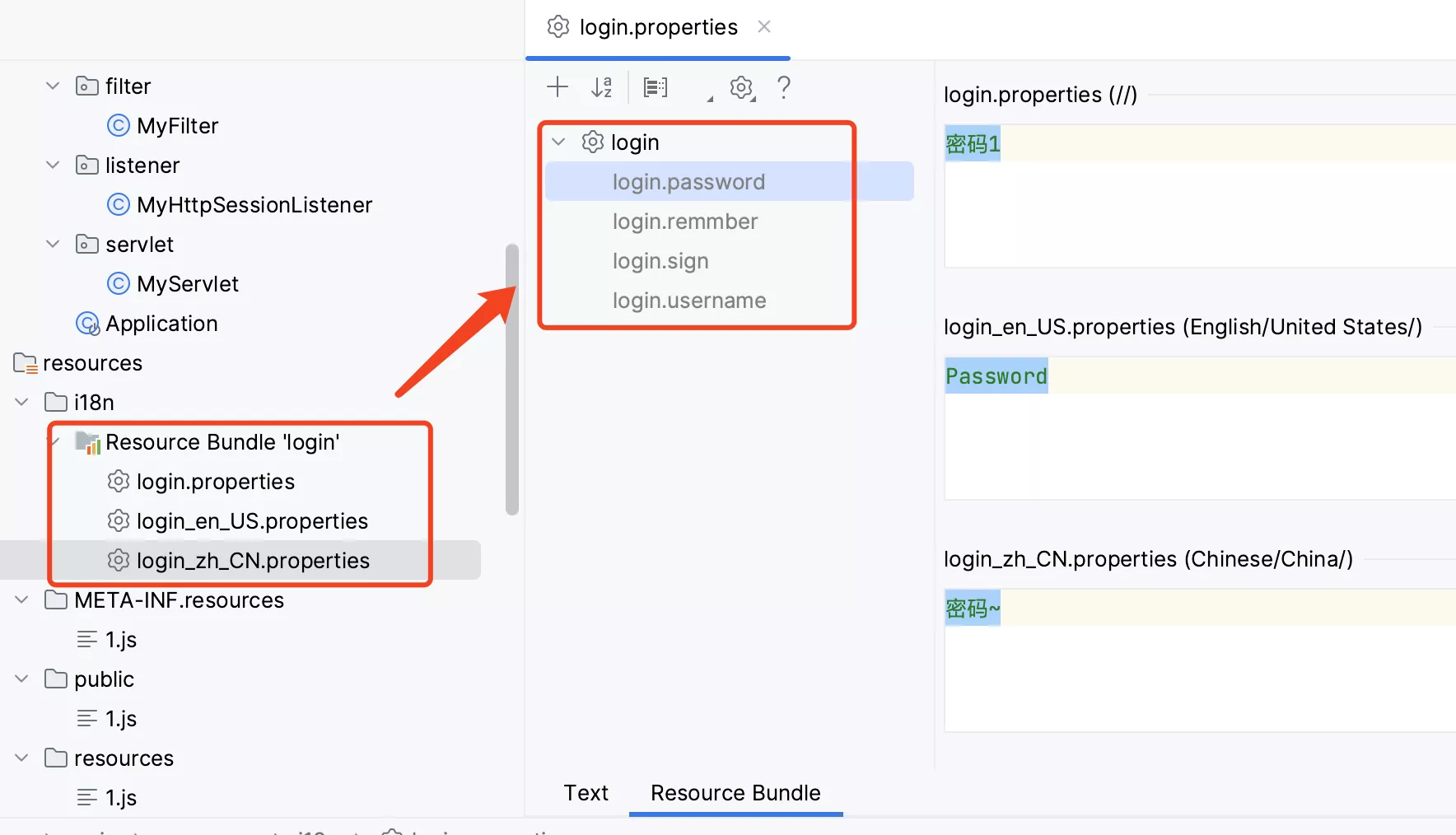
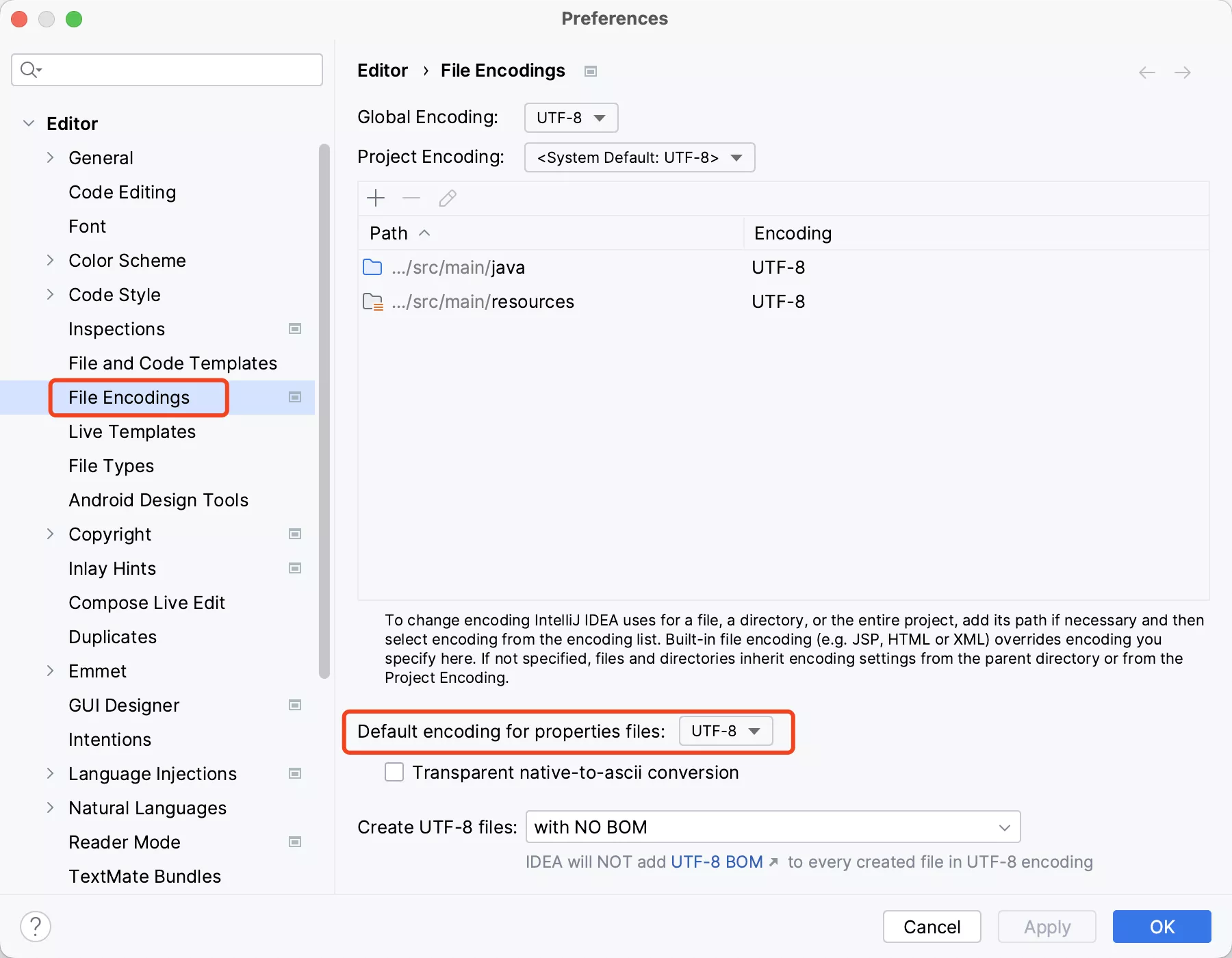
1. properties
# login.properties
login.password=密码1
login.remmber=记住我1
login.sign=登录1
login.username=用户名1
# login_en_US.properties
login.password=Password
login.remmber=Remember Me
login.sign=Sign In
login.username=Username
# login_zh_CN.properties
login.password=密码~
login.remmber=记住我~
login.sign=登录~
login.username=用户名~
2. yml
# 配置国际化的资源路径
spring:
messages:
basename: i18n/login
3. html
1. 原始页面
login0.html
<!DOCTYPE html>
<html lang="en" xmlns:th="http://www.thymeleaf.org">
<head>
<meta charset="UTF-8"/>
<title>Title</title>
</head>
<body>
<form action="" method="post">
<label>Username</label>
<input type="text" name="username" placeholder="Username">
<label>Password</label>
<input type="password" name="password" placeholder="Password">
<br> <br>
<div>
<label>
<input type="checkbox" value="remember-me"/> Remember Me
</label>
</div>
<br>
<button type="submit">Sign in</button>
<br> <br>
<a>中文</a>
<a>English</a>
</form>
</body>
</html>
2. 跟随浏览器切换语言
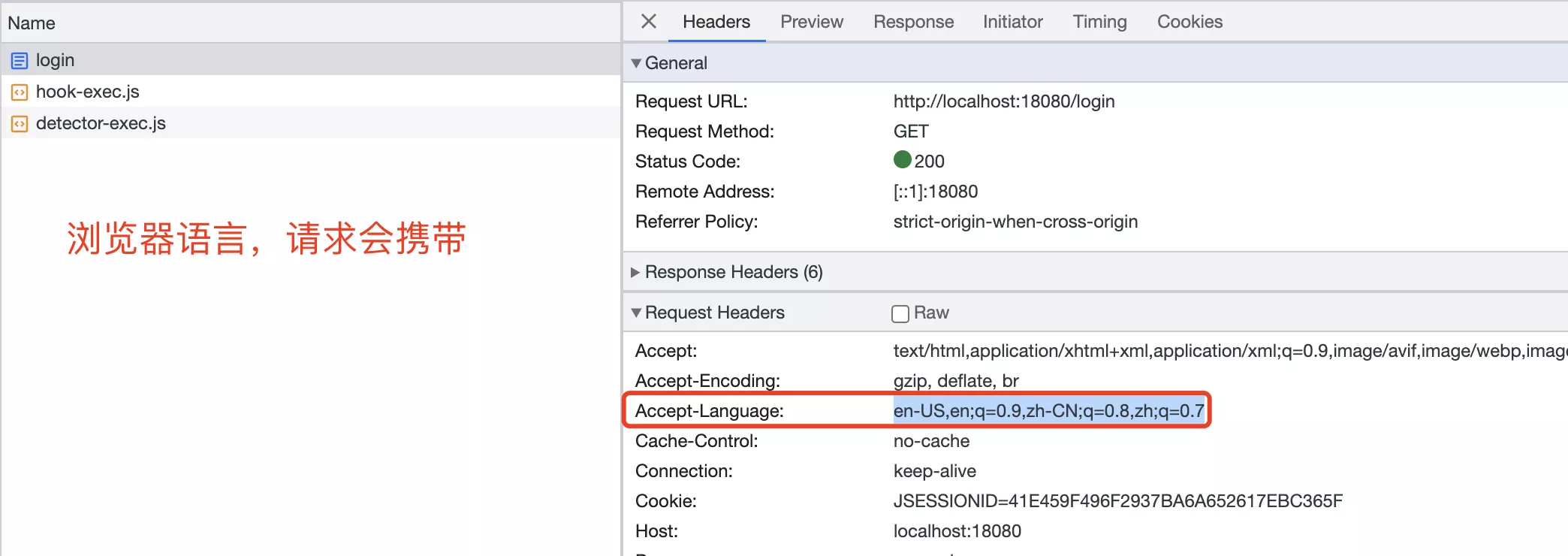
login1.html
<!DOCTYPE html>
<html lang="en" xmlns:th="http://www.thymeleaf.org">
<head>
<meta charset="UTF-8"/>
<title>Title</title>
</head>
<body>
<form action="" method="post">
<label th:text="#{login.username}">Username</label>
<input type="text" name="username" placeholder="Username" th:placeholder="#{login.username}">
<label th:text="#{login.password}">Password</label>
<input type="password" name="password" placeholder="Password" th:placeholder="#{login.password}">
<br> <br>
<div>
<label>
<input type="checkbox" value="remember-me"/> [[#{login.remember}]]
</label>
</div>
<br>
<button type="submit" th:text="#{login.sign}">Sign in</button>
<br> <br>
<a>中文</a>
<a>English</a>
</form>
</body>
</html>
3. 超链接实现
- 类比
WebMvcAutoConfiguration$WebMvcAutoConfigurationAdapter#localeResolver()
package com.listao.spring_boot.config;
@Configuration
class MyConfig implements WebMvcConfigurer {
@Override
public void addViewControllers(ViewControllerRegistry registry) {
registry.addViewController("/ooxx").setViewName("01_html");
registry.addViewController("/login.html").setViewName("login");
}
@Bean
public LocaleResolver localeResolver(){
return new NativeLocaleResolver();
}
protected static class NativeLocaleResolver implements LocaleResolver {
@Override
public Locale resolveLocale(HttpServletRequest request) {
String language = request.getParameter("language");
Locale locale = Locale.getDefault();
if(!StringUtils.isEmpty(language)){
String[] split = language.split("_");
locale = new Locale(split[0],split[1]);
}
return locale;
}
@Override
public void setLocale(HttpServletRequest request, HttpServletResponse response, Locale locale) {
}
}
}
login.html
<!DOCTYPE html>
<html lang="en" xmlns:th="http://www.thymeleaf.org">
<head>
<meta charset="UTF-8"/>
<title>Title</title>
</head>
<body>
<form action="" method="post">
<label th:text="#{login.username}">Username</label>
<input type="text" name="username" placeholder="Username" th:placeholder="#{login.username}">
<label th:text="#{login.password}">Password</label>
<input type="password" name="password" placeholder="Password" th:placeholder="#{login.password}">
<br> <br>
<div>
<label>
<input type="checkbox" value="remember-me"/> [[#{login.remmber}]]
</label>
</div>
<br>
<button type="submit" th:text="#{login.sign}">Sign in</button>
<br> <br>
<a th:href="@{/login.html(language='zh_CN')}">中文</a>
<a th:href="@{/login.html(language='en_US')}">English</a>
</form>
</body>
</html>
4. 源码解释
1. MsgSourceAutoConfiguration
@Configuration(proxyBeanMethods = false)
@ConditionalOnMissingBean(name = AbstractApplicationContext.MESSAGE_SOURCE_BEAN_NAME, search = SearchStrategy.CURRENT)
@AutoConfigureOrder(Ordered.HIGHEST_PRECEDENCE)
@Conditional(ResourceBundleCondition.class)
@EnableConfigurationProperties
public class MessageSourceAutoConfiguration {
// 配置文件可以直接放在类路径下叫:messages.properties,就可以进行国际化操作了
@Bean
@ConfigurationProperties(prefix = "spring.messages")
public MessageSourceProperties messageSourceProperties() {
return new MessageSourceProperties();
}
@Bean
public MessageSource messageSource(MessageSourceProperties properties) {
ResourceBundleMessageSource messageSource = new ResourceBundleMessageSource();
if (StringUtils.hasText(properties.getBasename())) {
// 设置国际化文件的基础名(去掉语言国家代码的)
messageSource.setBasenames(StringUtils
.commaDelimitedListToStringArray(StringUtils.trimAllWhitespace(properties.getBasename())));
}
if (properties.getEncoding() != null) {
messageSource.setDefaultEncoding(properties.getEncoding().name());
}
messageSource.setFallbackToSystemLocale(properties.isFallbackToSystemLocale());
Duration cacheDuration = properties.getCacheDuration();
if (cacheDuration != null) {
messageSource.setCacheMillis(cacheDuration.toMillis());
}
messageSource.setAlwaysUseMessageFormat(properties.isAlwaysUseMessageFormat());
messageSource.setUseCodeAsDefaultMessage(properties.isUseCodeAsDefaultMessage());
return messageSource;
}
}
2. WebMvcAutoConfiguration
@Configuration(proxyBeanMethods = false)
@ConditionalOnWebApplication(type = Type.SERVLET)
@ConditionalOnClass({ Servlet.class, DispatcherServlet.class, WebMvcConfigurer.class })
@ConditionalOnMissingBean(WebMvcConfigurationSupport.class)
@AutoConfigureOrder(Ordered.HIGHEST_PRECEDENCE + 10)
@AutoConfigureAfter({ DispatcherServletAutoConfiguration.class, TaskExecutionAutoConfiguration.class,
ValidationAutoConfiguration.class })
public class WebMvcAutoConfiguration {
public static final String DEFAULT_PREFIX = "";
public static final String DEFAULT_SUFFIX = "";
private static final String[] SERVLET_LOCATIONS = { "/" };
// Defined as a nested config to ensure WebMvcConfigurer is not read when not
// on the classpath
@Configuration(proxyBeanMethods = false)
@Import(EnableWebMvcConfiguration.class)
@EnableConfigurationProperties({ WebMvcProperties.class, ResourceProperties.class })
@Order(0)
public static class WebMvcAutoConfigurationAdapter implements WebMvcConfigurer {
@Bean
@ConditionalOnMissingBean
@ConditionalOnProperty(prefix = "spring.mvc", name = "locale")
public LocaleResolver localeResolver() {
if (this.mvcProperties.getLocaleResolver() == WebMvcProperties.LocaleResolver.FIXED) {
return new FixedLocaleResolver(this.mvcProperties.getLocale());
}
AcceptHeaderLocaleResolver localeResolver = new AcceptHeaderLocaleResolver();
localeResolver.setDefaultLocale(this.mvcProperties.getLocale());
return localeResolver;
}
}
}
3. AcceptHeaderLocaleResolver
public class AcceptHeaderLocaleResolver implements LocaleResolver {
private final List<Locale> supportedLocales = new ArrayList<>(4);
@Nullable
private Locale defaultLocale;
@Override
public Locale resolveLocale(HttpServletRequest request) {
Locale defaultLocale = getDefaultLocale();
if (defaultLocale != null && request.getHeader("Accept-Language") == null) {
return defaultLocale;
}
Locale requestLocale = request.getLocale();
List<Locale> supportedLocales = getSupportedLocales();
if (supportedLocales.isEmpty() || supportedLocales.contains(requestLocale)) {
return requestLocale;
}
Locale supportedLocale = findSupportedLocale(request, supportedLocales);
if (supportedLocale != null) {
return supportedLocale;
}
return (defaultLocale != null ? defaultLocale : requestLocale);
}
}